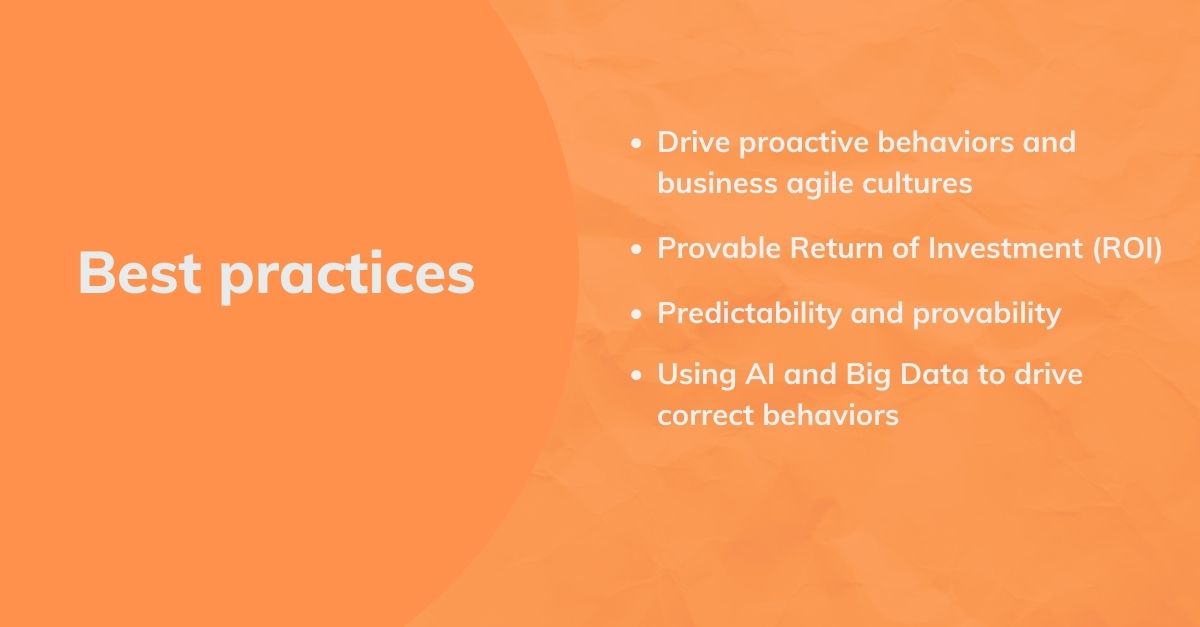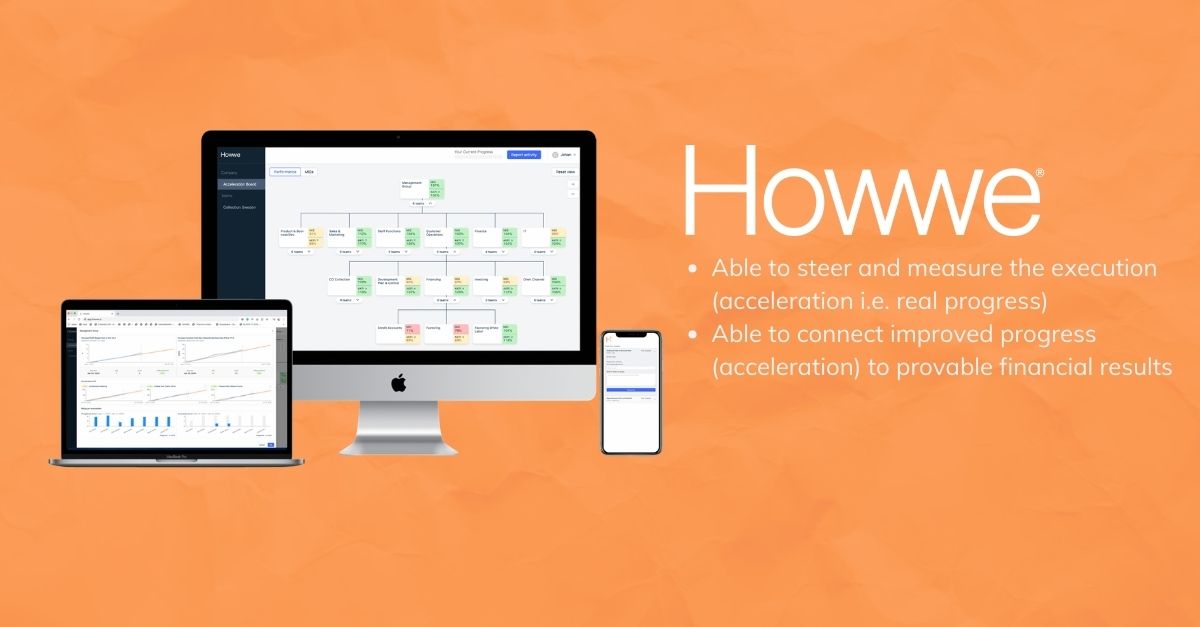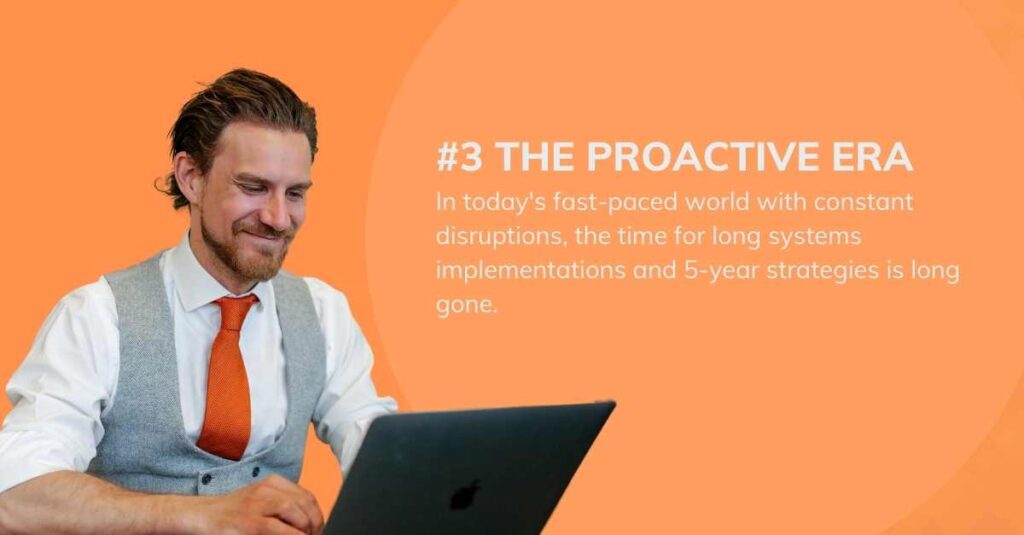This is the third and last blog post in a series by Johan Grönstedt, Chief Strategy Officer at Howwe Technologies. He covers all you need to know about Strategy Execution trends, platforms and the Howwe strategy execution software.
#3 The Proactive Era
This blog series had its starting point in the emergence of the digital era when software was reactive. It was followed by the Real-Time Era when software began to be proactive. We’ve reached the final era characterized by constant disruption where software also offers provable results.
In an era of constant disruptions, the time for long systems implementations and 5-year strategies is long gone.
Business leaders require faster time-to-effect since the opposite means going out of business. Especially within the medium to large company new traits are being idealized. The ability to quickly adapt to changeable market conditions, to foster accountability and intrapreneurship, and to increase focus on what is absolutely most important for the business is a matter of life and death for many companies.
As much as this wave is still under development, some commonly shared best practices are being developed:

1. Drive proactive behaviors and business agile cultures
The new currency of business is to build an execution machine, a business agile organization. This means the ability to execute a plan, relentlessly and seamlessly in the middle of volatile and changeable conditions.
In practice, this is quite difficult, since this means a heavy dependency on proactive behaviors from the whole organization at all levels. The reason it is difficult most of the time is that proactive behaviors mean behaviors that the employee is not comfortable with performing. It is something new, perhaps something a bit scary at first. It is something that employees might understand is good for the company, but that they wished someone else could do instead of them.
Historically, these types of requests from a manager to an employee were handled in the yearly development talk, supported by HR software. Individual development plans were formulated, most of the time quite vaguely. If the employee failed to meet the formulated behaviors, which was most often, new behaviors and goals were formulated for the coming year. Although this process is probably still needed for a variety of reasons, mostly emanating from the employee’s wish to be seen and appraised, it has on average failed to deliver on its intention.
Ultimately, business leaders increasingly are trained to cut through the bullshit. Not everything matters all the time. We need to focus on what is most important and not let the distractions become the majority of our work. For some leaders, roughly 20%, this comes naturally. The rest needs support. This is where the new generation of strategy execution platforms try to provide.
There are a couple of hurdles for this type of software to pass in order to properly support this type of execution and behavioral change.
Firstly, they must champion the CEO agenda, keeping strategy stringent throughout the organization, while still maintaining the bottom-up accountability introduced in the second wave. They must also help managers throughout the organization focus on what matters most, not necessarily what is most urgent or politically convenient. In order to do so, they must help the organization to make better prioritizations, most often through supporting the decision-making through focusing on financial potential[1].
Secondly, when the user is in the middle of execution, and when morale is at its lowest (remember that change is best avoided, according to most anyone who’s ever tried it…), the software absolutely must foster positive reinforcement. This, of course, is not a single feature. It is achieved through a multitude of tools, ranging from individually generated business cases feeding back the value of the individual’s effort, to agile stand-ups to remind of why and help with short-term planning and through the use of clever gamification elements and AI.
Don’t miss our video series about Business Agility.
Learn what Business Agility is, why it matters and how it works.
Thirdly, the software cannot be complex. As a user, it must be silly simple to use. As many change agents can attest, eliminating hurdles for change is paramount to achieving change within others. An easy way for change-hesitant users to avoid change is to blame the system, if it has any blamable flaws, otherwise, the employees have a tendency to blame.
But software doesn’t only exist on a user level. It must also deliver value on a strategic level for the top-level executives and payers, leading to the second big upcoming trend.
[1] An interesting side note; some top-modern Acceleration Software are currently using big data and AI to build databases of recommendations for different scenarios. This is turn is fed back to the end-users as recommendations based on the end-users company, strategy, and the team function (sales, IT, marketing, finance, etc.). This is intended to substitute a heavy dependency on either consultancy or the unavoidable mistakes that occur when a company tries this exercise unaided.
2. Provable Return of Investment (ROI)
CXOs were becoming increasingly insightful on the different pitfalls of software implementations. Many have reportedly attempted to implement more than 5 business-critical systems over the last 10 years and have struggled with the inability of most of the systems to deliver on the potential that was promised by the vendor.
The pressure was on for software companies not only to deliver their software but to take real responsibility for the business improvements it was intended to generate. This is quite difficult as a software provider since it mostly requires controlling the end-user behaviors [1]. This can either be done with strict governance structures in the client’s organization or an above-average UX and easy-to-use product.
It also entails spending time and effort to build good baselines on which to prove the improvement. All this costs money from the developer and is only recently becoming understood as crucial by software vendors.
Secondly, it was not only the CXO that was becoming more and more interested in the ROI’s. As shown above, a growing group of end-users requires more concrete feedback on the actual business value that is being created through the use of the software. This must also be provable or they will most times lose interest in the method or software over time, sadly most often before the majority of the business case has had time to be realized.
However, when dealing with business cases and ROI, as most who have tried can attest, business cases are many times over-theorized affairs. They occur post-factum, through a manual process where only the best effects are brought up and all the negatives are ignored. This has, sadly, become a quite mundane occurrence with management consultants and the like, and it is of paramount importance to not fall into the same trap. Just as in the science community, the results must be predictable and provable.
[1] Many systems, when used perfectly as intended, have the potential to generate a positive return of investment (ROI), but an overwhelming majority of software developers fail to generate the required behaviors from their end-users. Thus the systems are used wrong, too little, or only in part and the potential positive benefits of the systems are diluted. After a point some of these systems actually cost more (license and implementation & maintenance cost) than they generated, resulting in a negative ROI.

3. Predictability and provability
Predictability means the ability of software to predict a distinct outcome and the means of deriving the specific outcome and actually achieving the same result. Replicate the circumstances and get the same results, or more business applicable – predict a business case pre-factum (before any execution is begun and be correct while controlling for external factors) and be able to prove it.
This topic is easily misunderstood and perceived as of second-order importance. This is simply a failure to grasp the importance of the topic. Predictability means almost elimination of risk for the paying part. A guaranteed effect, provable, directly correlated with the CEO or BoD-agenda and highest prioritized financial plan. This is one of the few truly important reasons behind the almost 10x higher company valuation that exists for acceleration technology companies compared to traditional SaaS vendors.
4. Using AI and Big Data to drive correct behaviors
Although this topic was hinted at above, since it is one of the fastest rising trends it deserves a section of its own.
Some acceleration software is now in its third or even fourth year of market validation. This is the point when enough data has been generated to be used as a source of intelligence and, when fed back into both developments of the software and to end-users as gamification elements, it becomes very powerful. Normally, this is one of the more secretive points between developers since it can be, correctly implemented, a huge differentiator between similar software’s real-life effect.
Although the maturity of different developers will vary, the most advanced developers are currently deploying the first generation of AI consultants almost completely eliminating the dependency of costly anchoring and “get-started” costs for a strategy acceleration. Furthermore, the AI-consultants, sometimes branded more simply as Robo Advisors, Smart Insights, or Behavioral Suggestion / Nudging, are key to decrease the overall execution support costs, no matter whether the support is internal through specialists, or delegated to first- and second-line managers, or most commonly bought from consultants.
This trend has been on the horizon for some years, Harvard Business Review first wrote about it in 2017[1], concluding that “Robo Advisers will offer faster, better and more profound insights at a fraction of the cost and time of today’s consulting firms and other specialized workers” and the first real implementations of the same concept are proving just as profound as predicted back in 2017. Meanwhile, consulting companies respond by recommending software based on how much consulting they can sell and, effectively, how ineffective a software is, potentially beginning a death spiral for the old way of effecting change within companies. Thus, according to another HBR-article from 2018[2], the potential for acceleration software is to disrupt the management consulting market, currently with combined revenue of $b145 in the US market alone. This is one of the reasons behind PS50+ for some of the actors in this space.
[1] HBR 2017 – AI may soon replace even the most elite consultants
[2] HBR 2018 – Robo-advisers are coming to consulting and corporate strategy
The History of Strategy Execution Blog Series
One can say that strategy execution software has been around as long as strategies. This might not be completely true, but with the emergence of the digital era, companies have been searching for the best way to get help from software when it comes to their strategy execution efforts.
In this blog series we’ve been looking back at some clear trends during the last decades and divided them into three different eras.
#1 The reactive era
General strategy execution
From 19XX to 2013
#2 The real-time era
Proactive Software
From 2013
#3 The proactive era
Provable Proactive Software
From 2018
What are you waiting for?
Howwe is the Solution for Growth.
With our method and software, we simplify the execution of your strategy.




